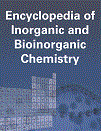Adenine Deaminase
Abstract
Adenine deaminase (ADE) is a member of the amidohydrolase superfamily of enzymes and this enzyme catalyzes the deamination of adenine to hypoxanthine. Biologically, this enzyme functions as a member of the purine salvage and catabolism pathways. ADE, expressed and purified from various bacterial sources, exhibits multiple levels of oxygenation modifications that lead to inactivation of catalytic activity. A special iron-free expression protocol is needed to obtain an active form of ADE. The X-ray structure of ADE exhibits a protein-fold that is somewhat different from other members of the amidohydrolase superfamily, although it maintains the central (β/α)8-barrel fold that is a characteristic feature of this superfamily. The active site contains a binuclear metal center with the metal ligands composed of four histidines, an aspartate, a glutamate, and another glutamate that bridges the two metals. The active form of ADE can utilize iron, manganese, or zinc with comparable catalytic efficiencies. Through a series of kinetic, biochemical, spectroscopic, and structural studies, the mechanism of deamination has been elucidated. The di-iron form of ADE shows a unique and aberrant catalase activity. In the presence of hydrogen peroxide the di-iron enzyme catalyzes the formation of reactive oxygen species that modify active site residues thereby resulting in enzyme inactivation.
3D Structure




